Abstract
The Suez Canal blockage (SCB) event, one of the world’s major transportation arteries, has attracted significant public attention. This article proposes a new leader–follower public-opinion evolution model on the SCB under online social media, which considers two aspects: (1) obtaining public opinion and attitudes about the SCB; and (2) grasping the evolutionary trend in public opinion on the SCB. To identify the sentiment tendency contained in the collected data, a hybrid sentiment analysis algorithm is presented to analyze Chinese and English data, which captures and analyzes public attitudes on the SCB. In addition, then, the opinion leader-identification mechanism algorithm is proposed, which divides leaders into three categories: positive, neutral and negative leaders. Moreover, the Hegselmann–Krause-based opinion leaders–followers opinion evolution model for the SCB event is established, which not only reflects the interaction of opinions among the online public, but also updates the opinions of the online public until it reaches a stable state. Finally, results and analysis for the SCB are discussed.
1. Introduction
Maritime transport has become the main mode of transport in international trade due to its advantages of large capacity, large volume, low freight, strong adaptability to goods and unique geographical conditions around the world [1]. However, in recent years, shipping incidents have occurred frequently and caused economic losses. On 23 March 2021, a large container ship, Ever Given, was stuck in the Suez Canal, causing bidirectional traffic paralysis and forcing more than 400 ships to drift in the Mediterranean Sea and Indian Ocean [2]. As soon as the stranding happened, many official channels reported the incident, which not only aroused the attention of the shipping industry, but also sparked the public’s concern and discussion. Meanwhile, the rapid development of social media has provided a platform for publics to express their opinions. Online comments on the Suez Canal blockage (SCB) not only inform us about public attitude and sentiment, but also influence the comments of others, which ultimately shape public opinion. Therefore, how to capture the public sentiment and guide public opinion effectively and in a timely manner is critical in view of the SCB incident, so as to prevent negative public sentiment towards similar maritime events in the future.
Affected by the blockage of the canal, not only the shortage of containers, rising freight rates and port congestion reappeared, but also inevitably brought about large fluctuations in international oil prices. Those directly affected by the SCB include ships planning to arrive/pass through the canal, shippers, ship owners, consignees, insurers, and carriers, etc. Obviously, the Suez Canal is considered to be one of the most reasonable shipping routes in the Eurasian region based on factors such as transportation costs and distance. However, the vulnerability of the Suez Canal has forced the international community to consider alternative routes by sea, which provides an opportunity for carriers and users to explore other routes or modes of transportation as backup plans. At present, the alternative maritime routes that are receiving attention mainly include: First, the International North–South Transport Corridor (INSTC), which is a project established by Russia, Iran and India; the waterway has limited operating hours each year and places high demands on ships. The second is the China–Europe Railway Express, which is a reliable choice for cargo owners based on safety and speed considerations. Moreover, the goods on board were stranded, resulting in delayed delivery of goods, loss or damage of goods, and even the risk of compensation for breach of contract for goods in transit, risk of capital turnover, risk of collection at destination, and loss of reputation. Meanwhile, with the emergence of alternative routes, the Egyptian government has to consider further the development of the Suez Canal. For example, the project to widen the southern channel of the Suez Canal started in July 2021, as well as others to implement maritime traffic control, and review the method, speed, and length of passing ships.
The main purpose of this article is to explore how the SCB affects public sentiment and triggers the fermentation of public opinion, so as to discover and guide public attitudes. In addition to the above-mentioned relevant groups being affected by the SCB incident, some people’s daily lives have also been indirectly disturbed. For example, affected by the SCB incident, some ships loaded with daily necessities could not reach the European region in time, resulting in shortages and price increases in some daily necessities, including toilet paper, coffee, children’s toys, furniture and electrical appliances, etc., which triggered the dissatisfaction of the public and boosted the development of vicious public opinion. In addition, although the rapid dissemination of information effectively alleviated information asymmetry, it also deceived netizens who did not know the truth of the incident, fueled flames with the help of public-opinion hype, and put the government in a passive and complex situation. At the same time, in the face of a situation of unprecedented congestion, due to the influence of the event itself and other online opinions, the online public felt different emotions, which, in turn, affected individual behavior choices. For example, public-opinion information could cause changes in investors’ emotions, and, correspondingly, change investors’ decision-making behavior. In the early days of the SCB event, large shipping stocks generally fell due to pessimistic public sentiment, including NYK (Tokyo, Japan), COSCO Shipping Holdings Co., Ltd. (Shanghai China) and M.c.pacific (Hong Kong, China). Therefore, it is necessary to effectively control and guide such public-opinion events, which could prevent public opinion from spiralling out of control. However, the existing literature only explore the social, economic and environmental impacts of congestion events [3,4,5,6,7], but there is no in-depth study of public sentiment and how to guide public opinion. When public opinion on SCB occurs and ferments, timely and effective response and management is an important issue in the management of such emergencies, which could shape the public’s thoughts and attitude and then control the development trend of public-opinion events accurately. Therefore, in this paper, a new method is designed to identify the public’s emotional tendencies and perform public-opinion evolution analysis on the congestion event.
The first issue is how to obtain a public’s opinions and attitude about the SCB. The rise in Internet platforms encourages the public to interact and comment on online communities, which contains an abundance of information, such as public opinions and attitude on specific events [8,9]. Sentiment analysis is an effective tool for mining online public opinion [10,11,12]. The emotions of a public are classified into three categories: positive, negative and neutral [13]. Sentiment analysis techniques are broadly divided into dictionary-based approaches and machine-learning-based approaches [14]. Compared with the machine-learning-based approach, the dictionary-based approach is suitable for short texts with finer granularity, and the results are generally more accurate within a shorter time. For example, Li et al. [15] proposed the text-mining analysis to explore the current status, temporal and spatial trends of public attention, sentiment orientation, and focus on recycled water in China based on social media text data. Inspired by Li et al. [15], this article designs the pseudo-code of the SnowNLP-TextBlob-based hybrid algorithm to obtain and analyze online public opinions on the SCB, in which the public’s emotions are divided into three categories: positive, neutral and negative.
The second issue is how to grasp the evolutionary trend of public opinion on the SCB. Since the online public are of different age groups, social statuses and professional knowledge, the online public has different views and opinions on the SCB, which leads to conflicts among the online public, promotes the fermentation of public opinion and hinders the reaching of a consensus [16,17,18,19,20]. Many opinion dynamic models have been developed to research the mechanism of group opinion formation, such as the DeGroot model [21], the voter model [22], social impact model [23] and the Hegselman–Krause (HK) [24,25]. Liang et al. [26] proposed the HK model based on bounded confidence and termed interval opinion dynamics with the dynamic bounded confidence. Motivated by Liang et al. [26], a new HK-based leader–follower opinion evolution model is proposed in this paper to analyze the evolution of public opinion regarding the SCB event and prevent the fermentation of public opinion.
Based on the above research and analysis, this paper establishes a new HK-based leader–follower public-opinion evolution model on the SCB from online social media. The main contributions of this article are as follows:
- (1)
- The SnowNLP-TextBlob-based hybrid sentiment analysis algorithm on the SCB incident is presented. First, the online public comments on the SCB are crawled from Twitter. Then, the crawled Chinese and English data are preprocessed using python. Finally, a SnowNLP-TextBlob-based hybrid algorithm is presented to analyze Chinese and English data, which captures and analyses public attitudes towards the SCB.
- (2)
- A new HK-based leader–follower public-opinion evolution model on the SCB is proposed. An opinion-leader identification mechanism is proposed, which divides the online public into opinion leaders and followers and further divides opinion leaders into active leaders, neutral leaders and negative leaders. In addition, then, the HK-based opinion leaders–followers opinion evolution algorithm for the SCB event is established, which not only reflects the interaction of opinions among the online public (between leaders and leaders, between leaders and followers, and between followers and followers), but also updates the opinions of the online public until it reaches a stable state.
The rest of this paper is organized as follows: The relevant theoretical foundation about sentiment analysis and the HK model is introduced in Section 2. In Section 3, the problem of the Suez Canal blockage is described. The sentiment analysis of online reviews is introduced, to capture the public sentiment about the SCB according to Twitter comments. Furthermore, a new HK-based opinion leaders–followers opinion evolution model on the SCB is proposed to update the online public opinion. Section 4 shows the results of the opinion dynamic and comparative analysis of different parameters. Finally, the conclusion and future work are discussed in Section 5.
2. Preliminary
This section introduces the basic knowledge regarding sentiment analysis and the HK model.
2.1. Studies on Sentiment Analysis
Sentiment analysis, also known as tendency analysis and opinion mining, is a process of analyzing, processing, evaluating and considering subjective texts with emotional colors [27]. Sentiment classification is one of the main tasks of sentiment analysis. It mainly classifies texts according to sentiment orientation. Generally speaking, emotions are classified into three categories: positive, negative and neutral [13]. Sentiment-analysis technology mainly includes two methods: dictionary-based approaches and machine-learning-based approaches [14,28]. The dictionary-based sentiment-analysis method obtains effective results in a short time. It is feasible to use sentiment analysis to investigate public opinion. A dictionary-based approach uses a linguistic resource called a sentiment dictionary or sentiment lexicon, such as SentiWordNet, SenticNet and Opinion Finder. In this article, it mainly uses TextBlob and SnowNlp for sentiment analysis. TextBlob, the Python library for processing textual data, provides a consistent API for jumping into general-purpose natural-language-processing (NLP) tasks such as part-of-speech tagging, noun-phrase extraction and sentiment analysis [29].
In the existing literature, sentiment analysis is mainly applied to decision support [30], personalized recommendation systems [31] and public-opinion monitoring. Georgiadou et al. [32] proposed that in the context of Brexit, sentiment analysis of related topics provides information support for the decision making of governments and organizations. In the commercial field, by analyzing the emotions in social networks, users’ own preferences are accurately reflected [33], and more precise commodities and contents are recommended to users, such as tourist destinations [8,34] and products [11,33].
2.2. Studies on Hegselmann–Krause Model
Opinion dynamics is the study of the formation and dissemination of public opinion on social networks. The research on the dynamics of public opinion began in the 1950s, and some basic models emerged [21]. According to the opinion value, the modeling of a collective opinion evolution is generally classified into two big categories: discrete opinion dynamics and continuous opinion dynamics [35]. The bounded confidence model describes the process of continuous opinion interaction, which includes the Deffuant–Weisbuch (DW) model [36] and the Hegselmann–Krause (HK) model [24]. The HK model is briefly introduced as follows:
Suppose that there are n agents in a social network, where each agent has an opinion at a discrete time . Let be the opinions profile of all of the agents at time t, and be the bounded confidence, which is used to restrict the scope of opinion neighbors. In the HK model, each agent updates his opinion by averaging the opinion of all agents whose opinions lie in his/her confidence range [37]. Let be the confidence set of agent i at time t, and the weight with which agent i distributes agent j at time t [38]; then
where and is the number of agents in set . Therefore, the HK model is described by:
The HK model adopts a synchronous updating process. When agents’ opinions are close enough to each other, that is, the distance between the opinion states is less than a certain confidence threshold, the agents can interact with each other [25]. Notably, the HK model is considered to be homogenous if the values are the same for different agents, and it is heterogeneous otherwise [37].
3. Methodology
3.1. Problem Description
Blockages have occurred frequently in the Suez Canal in recent years, disrupting shipping for short periods. Nevertheless, the grounding of the container ship Ever Given was a serious ship-jam accident in terms of loss amount [39], impact area and duration, and is called “the Great Jam ship of the century” [40]. On the one hand, the container market was obviously affected: the blockage led to the unbalanced distribution of containers, and then the prominent problem of container shortage and the rise in container prices. On the other hand, the blockage affected the supply of oil [7], gas and copper to the global market, and even threatened the production of toilet paper, which caused negative public sentiment and negative public opinion. Hence, it is meaningful to identify the public attitudes towards the Suez Canal blockages (SCB) and guide public opinion towards a positive trend. Figure 1 shows that the Ever Given was blocked in the Suez Canal. To solve the above problems, with the SCB incident as the background, the tweets on such topics are collected from the Twitter platform, and the sentiment analysis technology is used to obtain the public sentiment value of the event to identify the emotional tendency. Then, an HK-based leader–follower opinion evolution model framework based on sentiment analysis of online comments is constructed, which mainly includes three stages, as illustrated in Figure 2.

Figure 1.
The Suez Canal blockage (SCB) event.
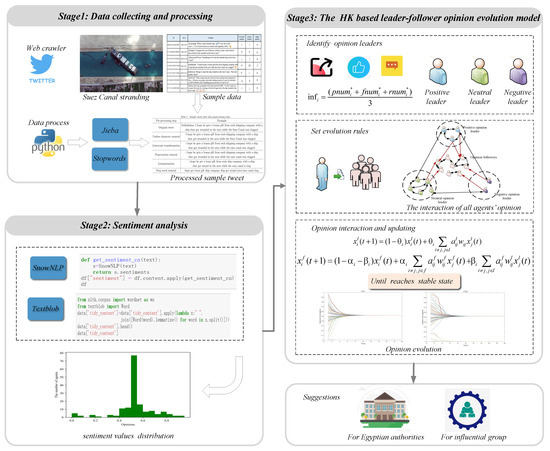
Figure 2.
Research framework of the leader–follower opinion evolution model for online comments.
- Stage 1:
- Data collecting and processing. At this stage, detailed in Section 3.2.1, the online reviews about the grounding of the Ever Given in the Suez Canal are extracted from Twitter. Then, the crawled Chinese and English data are preprocessed using Python.
- Stage 2:
- Sentiment analysis of the SCB. At this stage, clarified in Section 3.2.2, based on the cleaned textual data, the SnowNLP-TextBlob-based hybrid sentiment-analysis algorithm is presented to identify the sentiment tendency about the SCB, and the public’s emotions are divided into three categories: positive, neutral and negative online individuals.
- Stage 3:
- The HK-based leader–follower opinion evolution model. At this stage, elaborated in Section 3.3, the opinion-leaders-group identification mechanism is proposed. Then, the interactive weight is calculated by opinion distance. The HK-based opinion leaders–followers online individual evolution algorithm for the SCB event is established, which considers the opinion evolution rules of leaders and followers.
The symbol description is illustrated as follows:
- : the set of the online reviews about SCB;
- : the vector of the collective opinions, and is the initial opinion profile at time , where denotes the ith online individual’s opinion at time t, ;
- : the weight of jth opinion leader on ith opinion leader. When the opinion difference between ith leader and jth leader is smaller, leader i will assign leader j more weight;
- : the confidence threshold, which describes the tolerance degree of individuals to other different opinions. The larger the trust threshold, the wider the range of online individual interaction; it restricts online individuals to interacting within a range.
3.2. Sentiment Analysis of the Suez Canal Blockages
3.2.1. Data Collection and Preprocessing
In this study, the existing data are mainly from Twitter. Some Chinese and English tweets about the SCB are extracted from Twitter and analyzed in detail. The main reasons for choosing this web site are as follows: the grounding of the Ever Given in the Suez Canal has aroused widespread concern all over the world. Furthermore, as an online platform with many active users, Twitter is an important platform for gathering public opinions: it provides real-time public discussions, attitudes and reflections on a variety of opinions on different events, and the topics involving the SCB are frequently discussed on Twitter. The crawled data needs to be preprocessed through the following steps:
- Step 1:
- Crawling from Twitter.
The Ever Given was stuck in the Suez Canal on 21 March, then, it left the berth of the Great Bitter Lake in the Suez Canal on 7 July and received maintenance work in China in October. Therefore, the time range of the comment data collected in this paper is from 21 March to 1 October 2021. Data collection is the process of obtaining data and information from online resources, and the Twitter website is loaded asynchronously with AJAX. When searching through search keywords, we could use requests to request the json file that contains the data. Therefore, we used “Suez Canal blockage” and the Chinese of “Suez Canal blockage” as search keywords, and crawled relevant text information through Python. The web crawler is used to collect the searched web content, including the publisher ID, release time, content, number of forwards, likes and replies. Figure 3 shows some of the collected data.
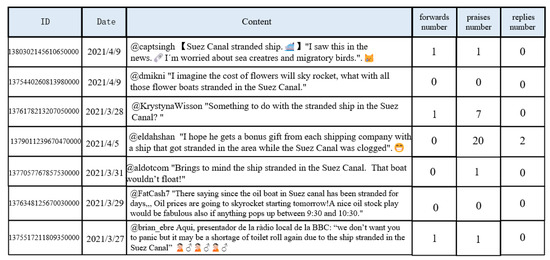
Figure 3.
Some online reviews about SCB.
- Step 2:
- Deleting tweets that are repetitive and from official media.
The collected text data contains the information published by the official media. Since this article analyzes the emotions contained in personal opinions, only tweets with an emotional tendency were retained.
- Step 3:
- Preprocessing the Chinese and English text data, respectively.
Since many online comments have a lot of emotions, links and pictures, we also removed these non-textual data and left only textual analysis. Then, we got rid of pauses and participles. Unlike English, Chinese sentences are not separated by spaces. Therefore, this paper uses Jieba to segment Chinese data sentences (https://pypi.python.org/pypi/jieba, accessed on 15 January 2022). Furthermore, for English tweets, all uppercase letters were converted to lowercase letters; then, Chinese and spelling errors were removed. Algorithm 1 shows the process of data preprocessing. The sample text after carrying out each preprocessing step is shown in Table 1. We filtered many news reports about SCB events during data preprocessing, leaving only public posts with subjective emotions. In addition, SCB was a major nautical event, but the number of individuals who paid close attention and posted comments at the same time are finite. Therefore, after preprocessing, the amount of opinion data is 170, including 27 in Chinese and 143 in English.

Table 1.
Sample tweets after data preprocessing steps.
| Algorithm 1: Data collection and preprocessing algorithm. |
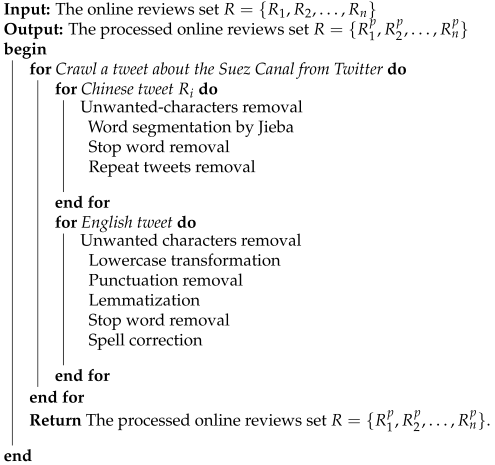 |
3.2.2. Sentiment Analysis Based on Twitter Comments
To identify the sentiment tendency and strength of text reviews about the SCB, this paper analyzes the sentiment involved in the comments based on dictionary-based approaches, so as to further understand the attitudes of the public towards the grounding. The detailed analysis steps are as follows:
- Step 1:
- Analyzing the sentiment tendency of text data.
This article uses the dictionary-based method for sentiment analysis. It collects subjective comments data with the topic of “Suez Canal blockage”, so the number of comments collected is limited. However, methods such as deep learning require a large amount of data support and are not suitable for small data sets. In addition, this paper not only has English text data, but also Chinese opinion data. In addition, Snownlp is inspired by Textblob, so it is feasible to use Textblob and Snownlp to analyze text sentiment, respectively.
Textblob is an open-source text-processing library programmed in Python which could be used to perform sentiment analysis on English texts. Its default analyzer is PatternAnalyzer, which would not be affected by the length of the target text, and matches the words in the built-in sentiment dictionary with the words in the target text that are pre-assigned with emotional values, and then obtains it according to the weighted average algorithm Target text sentiment polarity value. For example, Bhagat et al. [41] used the Textblob library to calculate sentiment scores for relevant topical texts, so as to analyze public perceptions of online learning during the COVID-19 pandemic. Snownlp is self-fulfilling and comes with a Chinese positive and negative emotion training set. Lu et al. [42] used the Snownlp library to conduct sentiment analysis on relevant microblog data in order to analyze the degree of influence of haze weather on the public’s emotions. Therefore, this paper uses Python’s TextBlob library for the sentiment analysis of English opinion data, and uses the Snownlp library for the sentiment analysis of Chinese opinion data. The pseudo-code of the SnowNLP-TextBlob-based hybrid algorithm is presented in Algorithm 2.
- Step 2:
- Standardizing sentiment value.
The range of sentiment scores calculated by TextBlob is . A sentiment score greater than 0 is a positive emotion, and less than 0 is a negative emotion. In contrast to TextBlob, SnowNLP’s returned sentiment score is in the range of . In order to facilitate calculation, the sentiment value of the obtained English data is mapped to a fixed interval through linear normalization. Figure 4 presents the distributions of sentiment values on the SCB, that is, the distributions of all online individuals’ initial opinion.
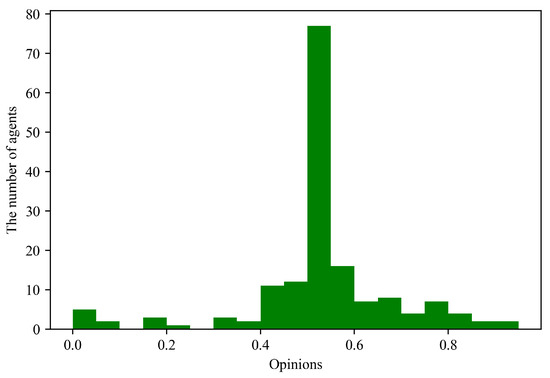
Figure 4.
Distribution of sentiment values on the Suez Canal stranding.
- Step 3:
- Constructing the opinion distribution chart.
According to the sentiment value obtained, the closer it is to 0, the more negative it is; on the contrary, the closer it is to 1, the more positive it is. In this study, the calculated sentiment value is taken as the opinion value of posting by default, and it utilizes Table 2 to present the number distribution of the initial opinion value.

Table 2.
Number distribution of the initial opinion value.
| Algorithm 2: The SnowNLP-TextBlob-based hybrid algorithm about the SCB. |
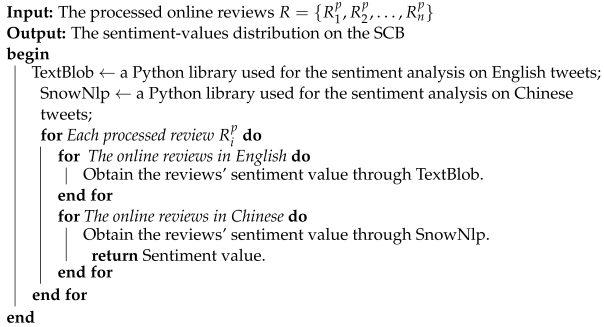 |
3.3. The HK-Based Leader–Follower Opinion Evolution Model about SCB
The rapid development of the Internet makes it convenient for people to share ideas and disseminate information. It is easy for people to interact with others, and express their opinions and feelings about a particular hot topic or event. In particular, in the process of public-opinion dissemination, some online individuals have a stronger ability to spread their own opinion and influence others’ opinions. Such online individuals are referred to as opinion leaders, and they have some common characteristics, such as being trustworthy, likable, influential and authoritative. In the analysis of public-opinion events regarding the SCB, an opinion evolution model was constructed which considers the factor of opinion leaders.
3.3.1. Identification of Opinion Leaders
Many existing studies consider opinion leaders and propose a number of definitions in different research fields and social situations. The concept of “opinion leader” was first mentioned by Lazarsfield in the book People’s Choice, which argued that information is spread by the process of “mass communication, opinion leader and general audience” [43]. Lazarsfeld et al. [43] defined the opinion leader as a charismatic person with outstanding psychological, physical and social characteristics. Zhao et al. [44] believe that opinion leaders are those who have greater influence on social media, which is defined as having more than 300,000 fans and more than 300 message forwards. In this paper, opinion leaders are regarded as those who influence the opinions of others and make most people trust them, meeting the following two conditions:
- Opinion leaders not only promote the dissemination of information, but also have certain influence;
- Opinion leaders have clear views and attitudes towards a certain event or behavior and receive attention and support from the group.
Based on this assumption, opinion leaders are measured by the influence of released information. The information influence of online publishers determines whether relevant information is noticed by enough people, which is also a necessary condition for becoming an opinion leader. Therefore, opinion leaders are identified by three indicators: the number of replies, forwards and likes of each tweet. The detailed calculation process of influence power is as follows:
- Step 1:
- Normalizing the index.
Due to the large difference in values under each index, in order to facilitate the calculation of each index, Equation (3) is used to normalize the three indicators:
where and are the number of forwards, likes and replies, respectively.
- Step 2:
- Calculating the influence of each individual.
Assuming that the weight of each indicator is the same, the influences of all online individuals are calculated by Equation (4):
where is the influence power of ith public. are the normalized number of forwards, likes and replies, respectively.
- Step 3:
- Selecting the opinion leader.
Based on the above analysis, the information influence of each online individual is evaluated and calculated, and the individual whose influence is greater than a certain threshold is selected as the opinion leader. In this paper, the online individual is identified as the opinion leader whose influence is greater than or equal to 0.2.
- Step 4:
- Dividing the opinion-leader group.
Opinion leaders, when publishing tweets related to SCB events, will not only state the facts, but also express their feelings and opinions, reflecting their own emotional tendencies in the text. Generally speaking, there are three main categories of sentiment tendencies: positive, negative and neutral. Therefore, based on Step 3, opinion leaders are further divided into three categories by the difference in sentiment value. Let and P denote the set of negative, neutral, and positive opinion leaders, respectively.
when the initial opinion value of the opinion leader is less than or equal to , it is considered as a negative opinion leader, while greater than or equal to is identified as the positive opinion leader. Otherwise, a neutral attitude is maintained. L is the set of all opinion leaders, while F is the set of all opinion followers. The pseudo-code of the algorithm for identifying and dividing opinion-leader groups is shown in Algorithm 3.
| Algorithm 3: The opinion-leader identification-mechanism algorithm. |
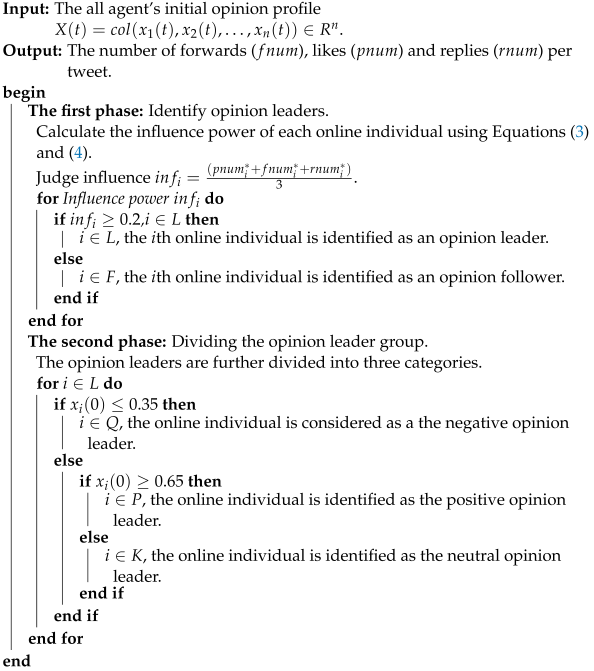 |
3.3.2. Opinion Interaction and Updating Procedure
In real life, when making a decision, the public tends to consult others’ opinions and exchange opinions with people they trust and with whom they have similar opinions. Therefore, a new dynamic model of social group opinion is constructed based on the theoretical framework of bounded confidence model. By default, the calculated sentiment value is taken as the individual opinion value, which reveals the evolution mechanism of group opinion under the influence of multiple opinion-leader subgroups. Details of the model are described as follows:
- Step 1:
- Setting evolution rules.
Based on the above analysis, this paper divides all online individuals into opinion leaders and opinion followers, and further divides opinion leaders into positive, neutral and negative leaders. Compared with opinion followers, opinion leaders tend to have a more comprehensive understanding of the same event, and their opinions are more reliable. Therefore, this paper assumes that in the process of opinion formation and diffusion, there are not only interactions among internal members of the three opinion-leader subgroups, but also interactions among opinion-leader subgroups. In addition, due to the susceptible characteristics of followers, followers are not only influenced by other followers but also by three types of opinion leaders during the interactions of public opinion. In particular, the aforementioned followers do not influence the opinion update of the corresponding leader. Figure 5 shows the interaction of all online individuals’ opinion about the SCB.
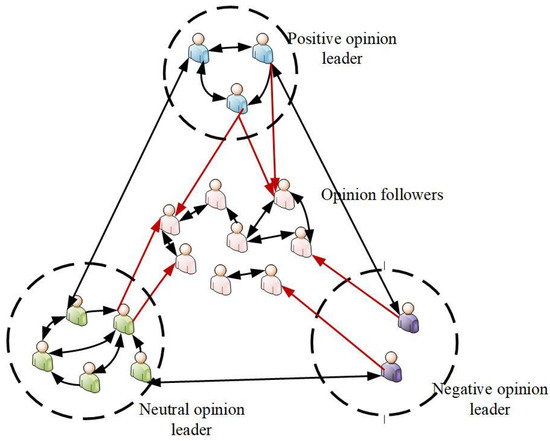
Figure 5.
Interaction of all online individuals’ opinion about the SCB.
- Step 2:
- Opinion interaction and updating procedure.
In social-network group decision making, individuals will be influenced by others with similar preferences and behaviors during opinion interactions, and more inclined to trust individuals with similar opinions. Therefore, we considered that individuals interact with people whose views differ within a certain threshold. In other words, individuals interact with other online individuals in their confidence set. When the opinion difference between online individuals i and j is smaller, online individual i will give online individual j more weight. The weights can be calculated from Equations (6) and (7).
where is the confidence set of online individual i at time t. is a smaller positive real number to ensure that when the difference in opinions is small, the weight is not too large. In this paper, is set to 0.01.
Based on the HK model mentioned above, an opinion-updating model is proposed for the opinion leader as follows:
where , when , there is a connection between online individual i and online individual j; otherwise, . In addition, is the confidence level of the opinion-leader group, which limits individuals to interacting within a certain range. is the degrees of trust assigned to the opinion-leader subgroup, and . When , opinion follower i is completely influenced by opinion leaders; on the contrary, if , opinion follower i completely distrusts opinion leaders.
Similarly, the opinion-followers updating model is proposed as follows:
where , is the confidence level of the opinion-follower group. and are the trust degrees, which are assigned to other opinion-followers and opinion-leader subgroups, respectively. and , respectively, represent the interactive weights given by follower i to other followers ( and leaders ( in the confidence set.
It is noted that we considered the similarity and ubiquity of individuals in the same group, assuming that all online individuals in the same group have homogeneous confidence levels. In other words, all opinion leaders have the same confidence levels, as well as opinion followers. Generally speaking, compared with opinion leaders, opinion followers have a greater confidence level, because followers are more easily persuaded by others.
- Step 3:
- Ending opinion Interaction.
When Equation (10) is satisfied, indicating that the group opinion has reached a stable state, the opinion iteration is finished [45]:
where is a very small positive number, which is set . The pseudo-code of the algorithm for the above process is shown in Algorithm 4.
| Algorithm 4: The HK-based leader–follower opinion interaction and updating algorithm. |
 |
4. Result and Analysis
In this section, based on the analysis of the data already collected, the values of some parameters are determined and applied throughout the experiment:
- The total number of online individuals is 170, including 21 leaders and 149 followers, among which the number of positive opinion leaders, neutral and negative leaders is 3, 16 and 2, respectively;
- All online individuals’ sentiment values were taken as the initial value of opinion, ;
- All online individuals were divided into a leader subgroup and follower subgroup with distinct confidence levels.
- The trust weight given by each follower to other followers and leaders satisfies , while the trust weight given to oneself is .
4.1. Confidence Levels of the Online Individuals
In order to accurately analyze the influence of the confidence level of opinion followers during opinion dissemination, two cases were considered, as follows:
- Case a:
- When the confidence level of the leader is unchanged, the confidence level of the f follower changes at
- Case b:
- When the confidence level of the follower is unchanged, the confidence level of the l leader changes at .
where the degree of trust followers have in other followers is , while in the leader subgroup, this is .
In Case a, let , and at the same time, it gradually increases the confidence level of the follower in order to explore the influence of followers’ confidence level on the evolution of public opinion. As shown in Figure 6 and Table 3, when the confidence level of the opinion leader is unchanged, with the increase in the confidence level of the followers, most of the online individuals eventually move towards the neutral opinion. This is because as the level of confidence increases, the scope of interaction expands, which leads to the followers’ opinions being influenced by more other online individuals. In addition, from Table 3, the evolution of the opinions of all online individuals also shows some characteristics: First, no matter how the confidence level changes over time, there are still individuals holding extreme values of opinions. Opinion leaders who hold particularly negative opinions do not change their opinions in the iteration because they only interact with other leaders and their opinions differ from other leaders by more than the confidence threshold. Second, with the increase in follower’s confidence level, the convergence speed of opinion followers accelerates, and the final opinions of all online individuals tend to be stable.
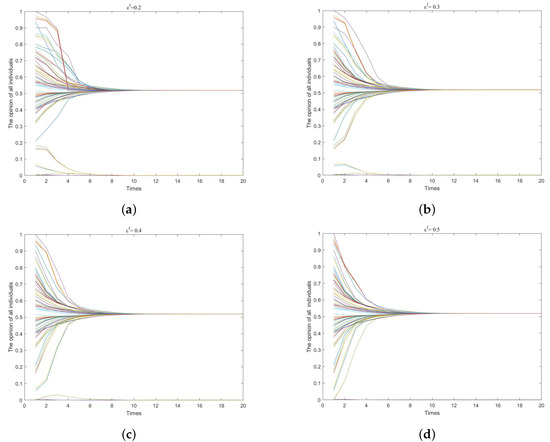

Figure 6.
The opinion evolution of all individuals with different confidence levels of the followers. , (a) , (b) , (c) , (d) , (e) , (f) .

Table 3.
Number distribution of all individuals in different ranges when and vary in .
In the above case, the confidence level of the leader always remains unchanged. However, the confidence level of opinion leaders will affect their interaction scope and the opinions of other leaders, and indirectly affect the evolution of followers’ opinions.
In Case b, in order to investigate the impact of opinion leaders’ confidence level under the three different leader subgroups, we changed leaders’ confidence level to vary from to and in units of . Figure 7 presents the opinion evolution of all online individuals with different confidence levels of leaders. Finally, the opinions of all online individuals converge to the neutral opinion subinterval. Moreover, compared with Table 3, when the confidence level of online leaders increases, opinions of all online individuals in Table 4 converge to the consensus at a faster speed, which indicates that the improvement in the confidence level of leaders promotes consensus in a shorter time.
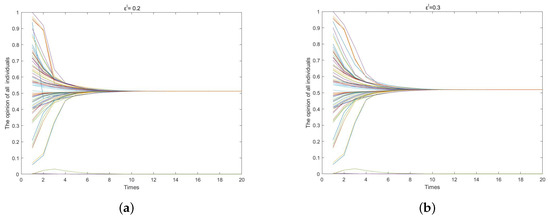

Figure 7.
The opinion evolution of all individuals with different confidence levels of the leader. (a) . (b) . (c) . (d) .

Table 4.
Number distribution of all individuals in different ranges when and vary in .
4.2. Trust Degrees of the Online Individuals
In this part, we explore the influence of the trust weights of individuals on the evolution of collective opinions by assigning different weights to different subgroups. It is assumed that the degree of trust satisfies the condition ; then, it gradually increases the followers’ degree of trust in the opinion-leader subgroup. Table 5 illustrates the number distribution of all online individuals in different ranges when we set to vary from to and ; it finds that there are always 5 people whose opinions are distributed in the subinterval , and the rest of the opinions are distributed in , which indicates that no matter how the weight given by followers to other followers or leaders changes, the result of the evolution of collective opinions will not be affected.

Table 5.
Number distribution of all individuals in different ranges when varies from 0.4 to 0.6.
5. Conclusions
In this article, the new HK-based leader–follower public-opinion evolution model on the SCB on online social media was proposed. To identify the sentiment tendency contained in the collected data, the SnowNLP-TextBlob-based hybrid sentiment analysis algorithm was presented to analyze Chinese and English data, which captures and analyses public attitudes on the SCB. Then, the opinion-leader identification-mechanism algorithm is proposed, which divides leaders into three categories: positive, neutral and negative leaders. The range of public opinion was put forward to calculate the interactive weight, which reflects the degree of influence between the online public opinion during the interaction. Moreover, the HK-based opinion leaders–followers opinion evolution model for the SCB event is established, which not only reflects the interaction of opinions among the online public, but also updates the opinions of the online public until it reaches a stable state. Finally, results and analysis for the SCB event were discussed.
Based on the theoretical research and analysis of SCB events in this paper, the following two suggestions are proposed.
- Whatever the public’s attitude, the level of confidence will affect the evolution of public opinion. When opinions are exchanged between highly trusted online individuals, it is easier to reach a consensus. It is seen that trust is closely related to shipping public-opinion events. In the face of the emotional panic caused by the SCB, it is important to ensure proper and timely information-dissemination channels. For example, when the SCB happened, the Egyptian government fully understands the cause and current situation of the stranding incident, outlines the real situation of the incident as soon as possible and prevents misleading news from spreading and public opinion from escalating.
- Opinion leaders have a great influence on the guidance of public opinion. Opinion leaders not only influence the direction of public-opinion evolution but also promote the convergence rate of online public opinion. Therefore, it is necessary to improve the authority and credibility of communities controlled by organizations or individuals, shape the credibility of individuals or organizations, so as to effectively control public opinion and prevent public opinion from deteriorating in the face of such sea-transportation obstruction events.
This paper has some limitations. In this paper, we only consider that all online individuals in the same subgroup have the same confidence level. In fact, the trust thresholds vary between all online individuals due to their differences in physical and psychological characteristics. Therefore, psychological behavior between online individuals should be considered in future studies.
Author Contributions
Conceptualization, Y.C. and T.G.; methodology, M.C.; software, Y.C. and T.G.; validation, Y.C. and T.G.; formal analysis, Y.C.; investigation, M.C.; resources, Y.C.; data curation, Y.C.; writing—original draft preparation, Y.C.; writing—review and editing, M.C.; visualization, Y.C. and T.G.; supervision, J.W.; project administration, Y.L. (Yan Li) and Y.L. (Yujia Liu); funding acquisition, J.W. and Y.L. (Yujia Liu). All authors have read and agreed to the published version of the manuscript.
Funding
This work was supported by National Natural Science Foundation of China (NSFC) (No. 71971135 and 72001134).
Institutional Review Board Statement
Not applicable.
Informed Consent Statement
Informed consent was obtained from all subjects involved in the study.
Data Availability Statement
Data is contained within the article.
Conflicts of Interest
The authors declare no conflict of interest.
References
- Zhi, Q. The impact of maritime energy transportation on the global shipping market. China Storage Transp. 2021, 10, 196–197. [Google Scholar]
- News: Suez Canal Blocked “Traffic Jam” Growing by the Hour. Available online: https://www.standard-club.com/knowledge-news/news-suez-canal-blocked-traffic-jam-growing-by-the-hour-1671/ (accessed on 25 May 2021).
- Baer, W. The Promoting and the Financing of the Suez Canal. Bus. Hist. Rev. 1956, 10, 196–197. [Google Scholar] [CrossRef]
- Taybany, A.; Moustafa, M.; Mansour, M.; Tawfik, A. Quantification of the exhaust emissions from seagoing ships in Suez Canal waterway. Alex. Eng. J. 2019, 58, 19–25. [Google Scholar] [CrossRef]
- Laih, C.; Chuang, Y.; Wang, R.; Sun, P. Development of an adjustable step toll scheme in compliance with expected effects of queuing reduction for the Suez Canal. Res. Transp. Bus. Manag. 2021, 44, 100717. [Google Scholar] [CrossRef]
- Xiao, G.; Wang, T.; Chen, X.; Zhou, L. Evaluation of Ship Pollutant Emissions in the Ports of Los Angeles and Long Beach. J. Mar. Sci. Eng. 2022, 10, 1206. [Google Scholar] [CrossRef]
- Alfadhli, M.; Alali, M.; Alkulaib, H. The Effect of Suez Canal Blockage on Crude Oil Prices: An Event Study Analysis. J. Bus. Manag. 2022, 23, 64–66. [Google Scholar]
- Wu, J.; Hong, Q.; Cao, M.; Liu, Y.; Fujita, H. A group consensus-based travel destination evaluation method with online reviews. Appl. Intell. 2022, 52, 1306–1324. [Google Scholar] [CrossRef]
- Ji, F.; Cao, Q.; Li, H.; Fujita, H.; Liang, C.; Wu, J. An online reviews-driven large-scale group decision making approach for evaluating user satisfaction of sharing accommodation. Expert. Syst. Appl. 2023, 213, 118875. [Google Scholar] [CrossRef]
- Bi, J.; Liu, Y.; Fan, Z. Representing sentiment analysis results of online reviews using interval type-2 fuzzy numbers and its application to product ranking. Inform. Sci. 2019, 504, 293–307. [Google Scholar] [CrossRef]
- Liu, Y.; Bi, J.; Fan, Z. Ranking products through online reviews: A method based on sentiment analysis technique and intuitionistic fuzzy set theory. Inform. Fusion 2017, 36, 149–161. [Google Scholar] [CrossRef]
- Song, C.; Wang, X.; Cheng, P.; Wang, J.; Li, L. SACPC: A framework based on probabilistic linguistic terms for short text sentiment analysis. Knowl.-Based Syst. 2020, 194, 105572. [Google Scholar] [CrossRef]
- Sailunaz, K.; Alhajj, R. Emotion and sentiment analysis from Twitter text. J. Comput. Sci. 2019, 36, 101003. [Google Scholar] [CrossRef]
- Li, H.; Chen, Q.; Zhong, Z.; Gong, R.; Han, G. E-word of mouth sentiment analysis for user behavior studies. Inform. Process. Manag. 2022, 59, 102784. [Google Scholar] [CrossRef]
- Li, L.; Liu, X.; Zhang, X. Public attention and sentiment of recycled water: Evidence from social media text mining in China. J. Clean Prod. 2021, 303, 126814. [Google Scholar] [CrossRef]
- Cao, M.; Wu, J.; Chiclana, F.; Ureña, R.; Herrera-Viedma, E. A personalized consensus feedback mechanism based on maximum harmony degree. IEEE Trans. Syst. Man Cybern. Syst. 2022, 51, 6134–6146. [Google Scholar] [CrossRef]
- Wu, J.; Chen, J.; Liu, W.; Liu, Y.; Liang, C.; Cao, M. A Calibrated Individual Semantic Based Failure Mode and Effect Analysis and Its Application in Industrial Internet Platform. Mathematics 2022, 10, 2492. [Google Scholar] [CrossRef]
- Gai, T.; Cao, M.; Chiclana, F.; Zhang, Z.; Dong, Y.; Herrera-Viedma, E.; Wu, J. Consensus-trust Driven Bidirectional Feedback Mechanism for Improving Consensus in Social Network Large-group Decision Making. Group Decis. Negot 2022. [Google Scholar] [CrossRef]
- Cao, M.; Liu, Y.; Gai, T.; Zhou, M.; Fujita, H.; Wu, J. A Comprehensive Star Rating Approach for Cruise Ships Based on Interactive Group Decision Making with Personalized Individual Semantics. J. Mar. Sci. Eng. 2022, 10, 638. [Google Scholar] [CrossRef]
- Wu, J.; Wang, S.; Chiclana, F.; Herrera-Viedma, E. Two-Fold Personalized Feedback Mechanism for Social Network Consensus by Uninorm Interval Trust Propagation. IEEE T. Cybern. 2022, 52, 11081–11092. [Google Scholar] [CrossRef]
- Degroot, M. Reaching a consensus. J. Am. Stat. Assoc. 1974, 69, 118–121. [Google Scholar] [CrossRef]
- Sznajd, K.; Sznajd, J. Opinion dynamics in closed community. Int. J. Mod. Phys. 2000, 11, 1157–1165. [Google Scholar] [CrossRef]
- Latan, B. The Psychology of Social Impact. Am. Psychol. 1981, 36, 343–356. [Google Scholar] [CrossRef]
- Hegselmann, R.; Krause, U. Opinion dynamics and bounded confidence: Models, analysis and simulation. JASSS J. Artif. Soc. S 2002, 5, 1–2. [Google Scholar]
- Zhao, Y.; Kou, G.; Peng, Y.; Chen, Y. Understanding influence power of opinion leaders in e-commerce networks: An opinion dynamics theory perspective. Inform. Sci. 2018, 426, 131–147. [Google Scholar] [CrossRef]
- Liang, H.; Li, C.; Dong, Y.; Jiang, Y. The fusion process of interval opinions based on the dynamic bounded confidence. Inform. Fusion 2016, 29, 112–119. [Google Scholar] [CrossRef]
- Lin, Y.; Chen, W.; Xue, L. A survey of sentiment analysis in social media. Knowl. Inf. Syst. 2018, 60, 617–663. [Google Scholar]
- Liu, Y.; Bi, J.; Fan, Z. A method for multi-class sentiment classification based on an improved one-vs-one (OVO) strategy and the support vector machine (SVM) algorithm. Inform. Sci. 2017, 394, 38–52. [Google Scholar] [CrossRef]
- Aljedaani, W.; Rustam, F.; Mkaouer, M.; Ghallab, A.; Rupapara, V.; Washington, P.; Lee, E.; Ashraf, I. Sentiment analysis on Twitter data integrating TextBlob and deep learning models: The case of US airline industry. Knowl.-Based. Syst. 2022, 255, 109780. [Google Scholar] [CrossRef]
- Wan, Q.; Xu, X.; Zhuang, J.; Pan, B. A sentiment analysis-based expert weight determination method for large-scale group decision-making driven by social media data. Expert Syst. Appl. 2021, 185, 115629. [Google Scholar] [CrossRef]
- Fan, Z.; Li, G.; Liu, Y. Processes and methods of information fusion for ranking products based on online reviews: An overview. Inform. Fusion 2020, 60, 87–97. [Google Scholar] [CrossRef]
- Georgiadou, E.; Angelopoulos, S.; Drake, H. Big data analytics and international negotiations: Sentiment analysis of Brexit negotiating outcomes. Int. J. Infrom. Manag. 2020, 51, 102048. [Google Scholar] [CrossRef]
- Karthik, R.; Ganapathy, S. A fuzzy recommendation system for predicting the customers interests using sentiment analysis and ontology in e-commerce. Appl. Soft Comput. 2021, 108, 107396. [Google Scholar] [CrossRef]
- Abbasi, Z.; Vahdat, H.; Sadri, J. Tourism recommendation system based on semantic clustering and sentiment analysis. Expert Syst. Appl. 2021, 167, 114324. [Google Scholar] [CrossRef]
- Zhao, Y.; Zhang, L.; Tang, M.; Kou, G. Bounded confidence opinion dynamics with opinion leaders and environmental noises. Comput. Oper. Res. 2015, 74, 205–213. [Google Scholar] [CrossRef]
- Deffuant, G.; Neau, D.; Amblard, F. Mixing beliefs among interacting agents. Adv. Complex Syst. 2000, 3, 87–98. [Google Scholar] [CrossRef]
- Gang, K.; Zhao, Y.; Peng, Y.; Shi, Y. Multi-Level Opinion Dynamics under Bounded Confidence. PLoS ONE 2012, 7, e4350. [Google Scholar]
- Li, K.; Liang, H.; Kou, G.; Dong, Y. Opinion dynamics model based on the cognitive dissonance: An agent-based simulation. Inform. Fusion 2020, 56, 1–14. [Google Scholar] [CrossRef]
- For Blocking the Suez Canal, How Egypt Scaled Back Its Ambitions. Available online: https://lejournaldelafrique.com/en/for-the-blocking-of-the-suez-canal-how-egypt-lowered-its-ambitions (accessed on 28 October 2022).
- Huge Ship Stuck Sideways in Suez Canal. Available online: https://www.kidsnews.com.au/geography/huge-ship-stuck-sideways-in-suez-canal/newsstory/232f669b662c04063f9509611e73b43c/ (accessed on 25 March 2021).
- Bhagat, K.; Mishra, S.; Dixit, A.; Chang, C. Public Opinions about Online Learning during COVID-19: A Sentiment Analysis Approach. Sustainability 2021, 13, 3346. [Google Scholar] [CrossRef]
- Lu, H.; Rui, X.; Gemechu, G.; Li, R. Quantitative Evaluation of Psychological Tolerance under the Haze: A Case Study of Typical Provinces and Cities in China with Severe Haze. Int. J. Environ. Res. Public Health 2022, 19, 6574. [Google Scholar] [CrossRef]
- Lazarsfeld, P.; Berelson, B.; Gaudet, H. The People’s Choice; Columbia University Press: Oxford, UK, 1944. [Google Scholar]
- Zhao, J.; He, H.; Zhao, X.; Li, J. Modeling and simulation of microblog-based public health emergency-associated public opinion communication. Inform. Process. Manag. 2022, 59, 102846. [Google Scholar] [CrossRef]
- Liang, H.; Li, C.; Jiang, G.; Dong, Y. Preference evolution model based on Wechat-like interactions. Knowl.-Based Syst. 2019, 185, 104998. [Google Scholar] [CrossRef]
Publisher’s Note: MDPI stays neutral with regard to jurisdictional claims in published maps and institutional affiliations. |
© 2022 by the authors. Licensee MDPI, Basel, Switzerland. This article is an open access article distributed under the terms and conditions of the Creative Commons Attribution (CC BY) license (https://creativecommons.org/licenses/by/4.0/).